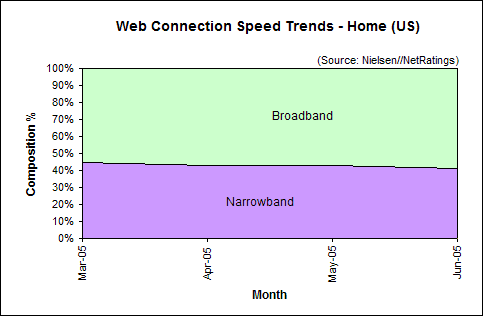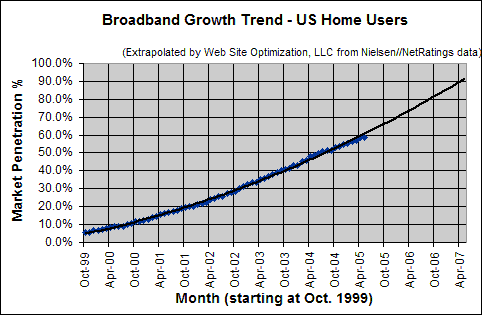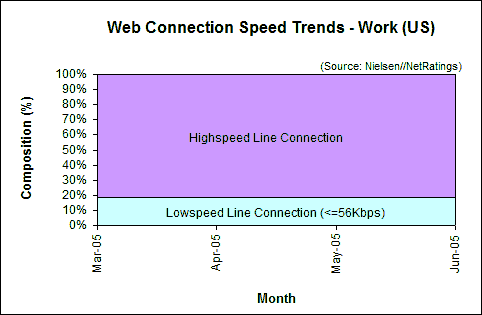The FCC’s recent broadband penetration report has critics wondering about its accuracy. Is the FCC fudging US broadband figures to avoid taking “immediate action” or artificially inflate penetration rates to help the President meet his stated goal of “universal, affordable access to broadband by 2007”? Only time will tell. Meanwhile, in June, US broadband jumped 1.36 percentage points to 58.57% among active Internet users.
Note that as of this month, the Bandwidth Report will track broadband and narrowband growth only using a new system of measurement. The new NetRatings NetSpeed report finds web connection speeds more accurately using additional parameters. The charts below, derived from Nielsen//NetRatings data, show trends in connection speeds to the Internet for United States users.*
Home Connectivity in the US
Most active Internet users connect from home with broadband connections. As of June 2005, narrowband users (56Kbps or less) comprise 41.43% of active Internet users in the US, down 1.36 percentage points from 42.79% in May 2005 (see Figure 1).
Web Connection Speed Trends – Home Users (US)
Figure 1: Web Connection Speed Trends – Home Users (US)
Source: Nielsen//NetRatings
Broadband and Narrowband Percentage of Internet Households
| Connection Speed | March 2005 | April 2005 | May 2005 | June 2005 |
|---|---|---|---|---|
| Narrowband | 44.63% | 43.18% | 42.79% | 41.43% |
| Broadband | 55.37% | 56.82% | 57.21% | 58.57% |
Broadband Growth in the US
Broadband penetration in the US grew by 1.36 percentage points to 58.57% in June, up from 57.21% in May. Note that these figures are based on Nielsen//NetRatings new NetSpeed report, and are not directly comparable to our previous figures. Since we have only four data points from the new survey, we base our future broadband penetration rates on the previous month’s data. Based on the growth rate we tracked until last month, broadband penetration among active Internet users in the US should break 60% by the third quarter of 2005 (see Figure 2).
Broadband Connection Speed Trend – Home Users (US)
Figure 2: Broadband Connection Speed Trend – Home Users (US)
Extrapolated from Nielsen//NetRatings data
Work Connectivity
Most workers in the US enjoy high-speed connections to the Internet. Most use a high-speed line such as a T1 connection, and share bandwidth between computers connected to an Ethernet network. The speed of each connection decreases as more employees hook up to the LAN. As of June of 2005, of those connected to the Internet, 81.74% of US users at work enjoy a high-speed connection, up 0.25 percentage points from the 81.49% share in May. At work, 18.26% connect at 56Kbps or less (see Figure 3).
Web Connection Speed Trends – Work Users (US)
Figure 3: Web Connection Speed Trends – Work Users (US)
Source: Nielsen//NetRatings
Broadband Percentage of Workplaces
| Connection Speed | March 2005 | April 2005 | May 2005 | June 2005 |
|---|---|---|---|---|
| Narrowband | 18.65% | 18.72% | 18.51% | 18.26% |
| Broadband | 81.35% | 81.28% | 81.49% | 81.74% |
FCC Fudging Broadband Penetration Stats?
With the release of their recent broadband penetration report, the FCC is being criticized by a number of critics of fudging the figures. FCC chief Kevin Martin crows that the U.S. “leads the world in the total number of broadband connections with 38 million subscribers,” and that we are “well on our way to accomplishing the President’s goal of universal, affordable access to broadband by 2007.” What he doesn’t highlight is that the U.S. stands 16th in overall broadband penetration. In fact, the US is a generation behind leading countries in high-speed broadband adoption. Critics point to the facts that the FCC reclassified broadband as any connection over 200kbps and count any ZIP code as broadband enabled if just one resident is wired for broadband. Is the FCC fudging the figures to avoid taking “immediate action” or to help meet the administration’s broadband goals?
Further Reading
- FCC Broadband Stats: Junk?
- A number of critics are wondering whether the FCC’s recent report on broadband penetration is accurate. Broadband Reports, July 26, 2005.
- FCC Releases Data on High-Speed Services for Internet Access
- According to the FCC, high-speed connections to the Internet (defined as > 200kbps) increased by 34% in 2004, for a total of 38 million lines of service. Federal Communications Commission, July 7, 2005.
- FCC Broadband Report Promotes Calls for Greater Penetration
- While the number of U.S. broadband Internet subscribers grew by 34 percent in 2004, some policymakers fear that increase is happening too slowly.
- IDC Predicts 46% of Western European Households Will Have Broadband by 2009
- “According to a new IDC study, broadband penetration in Western Europe will continue to surge in coming years. By 2009, 46% of Western European households will have broadband access, compared to 20% at the end of 2004.”
- Nielsen//NetRatings
- Provides the US broadband data (percentage of active Internet users) for the Bandwidth Report.
*Note that Nielsen//NetRatings new NetSpeed report differs from the previous Web connection data in two ways. First NetSpeed determines the connection speeds of the Digital Media Universe, which combines Web traffic, Internet applications and proprietary channels. The old Web connection data was based solely on Web traffic. The other difference is that the old Web connection data was based on panelists where the linespeeds are known. Since linespeeds don’t change often, if a panelists has an unknown linespeed, their previous month’s speed is taken.
The Bandwidth Report is featured monthly on URLwire – news of useful and unique web content since 1994.



